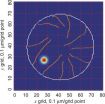(Press-News.org) The combination of two neuroprotective therapies, voluntary physical exercise, and the daily intake of melatonin has been shown to have a synergistic effect against brain deterioration in rodents with three different mutations of Alzheimer's disease.
A study carried out by a group of researchers from the Barcelona Biomedical Research Institute (IIBB), in collaboration with the University of Granada and the Autonomous University of Barcelona, shows the combined effect of neuroprotective therapies against Alzheimer's in mice.
Daily voluntary exercise and daily intake of melatonin, both of which are known for the effects they have in regulating circadian rhythm, show a synergistic effect against brain deterioration in the 3xTg-AD mouse, which has three mutations of Alzheimer's disease.
"For years we have known that the combination of different anti-aging therapies such as physical exercise, a Mediterranean diet, and not smoking adds years to one's life," Coral Sanfeliu, from the IIBB, explains to SINC. "Now it seems that melatonin, the sleep hormone, also has important anti-aging effects".
The experts analysed the combined effect of sport and melatonin in 3xTg-AD mice which were experiencing an initial phase of Alzheimer's and presented learning difficulties and changes in behaviour such as anxiety and apathy.
The mice were divided into one control group and three other groups which would undergo different treatments: exercise –unrestricted use of a running wheel–, melatonin –a dose equivalent to 10 mg per kg of body weight–, and a combination of melatonin and voluntary physical exercise. In addition, a reference group of mice were included which presented no mutations of the disease.
"After six months, the state of the mice undergoing treatment was closer to that of the mice with no mutations than to their own initial pathological state. From this we can say that the disease has significantly regressed," Sanfeliu states.
The results, which were published in the journal Neurobiology of Aging, show a general improvement in behaviour, learning, and memory with the three treatments.
These procedures also protected the brain tissue from oxidative stress and provided good levels of protection from excesses of amyloid beta peptide and hyperphosphorylated TAU protein caused by the mutations. In the case of the mitochondria, the combined effect resulted in an increase in the analysed indicators of improved performance which were not observed independently.
Treatment not easily transferable to humans
"Transferring treatments which are effective in animals to human patients is not always consistent, given that in humans the disease develops over several years, so that when memory loss begins to surface, the brain is already very deteriorated," the IIBB expert points out.
However, several clinical studies have found signs of physical and mental benefits in sufferers of Alzheimer's resulting from both treatments. The authors maintain that, until an effective pharmacological treatment is found, adopting healthy living habits is essential for reducing the risk of the disease appearing, as well as reducing the severity of its effects.
The melatonin debate
The use of melatonin, a hormone synthesized from the neurotransmitter serotonin, has positive effects which can be used for treating humans. With the approval of melatonin as a medication in the European Union in 2007, clinical testing on this molecule has been increasing. It has advocates as well as detractors, and the scientific evidence has not yet been able to unite the differing views.
According to the Natural Medicines Comprehensive Database, melatonin is probably effective in sleeping disorders in children with autism and mental retardation and in blind people; and possibly effective in case of jet-lag, sunburns and preoperative anxiety.
"However, other studies which use melatonin as medication show its high level of effectiveness," Darío Acuña-Castroviejo explains to SINC. He has been studying melatonin for several years at the Health Sciences Technology Park of the University of Granada.
The expert points out that international consensus already exists, promoted by the British Association for Psychopharmacology –also published in the Journal of Psychopharmacology in 2010–, which has melatonin as the first choice treatment for insomnia in patients above the age of 55. This consensus is now being transferred to cases of insomnia in children.
Its use in treating neurodegenerative diseases is acquiring increasing scientific support in lateral amyotrophic sclerosis, in Alzheimer's, and Duchenne muscular dystrophy.
"Even though many more studies and clinical tests are still required to assess the doses of melatonin which will be effective for a wide range of diseases, the antioxidant and anti-inflammatory properties of melatonin mean that its use is highly recommended for diseases which feature oxidative stress and inflammation," Acuña-Castroviejo states.
This is the case for diseases such as epilepsy, chronic fatigue, fibromyalgia, and even the aging process itself, where data is available pointing to the benefits of melatonin, though said data is not definitive.
INFORMATION:
Reference:
García-Mesa Y, Giménez-Llort L, López LC, Venegas C, Cristòfol R, Escames G, Acuña-Castroviejo D, Sanfeliu C. "Melatonin plus physical exercise are highly neuroprotective in the 3xTg-AD mouse". Neurobiol Aging 2012 Jun; 33(6):1124.e13-29.
Contact:
Coral Sanfeliu
Instituto de Investigaciones Biomédicas de Barcelona (IIBB)
Tel.: +34 93.363.83.38
Email: coral.sanfeliu@iibb.csic.es
About melatonina:
Darío Acuña-Castroviejo
Centro de Investigación Biomédica
Parque Tecnológico de Ciencias de la Salud
Universidad de Granada
Telf.: +34 958 241000, ext. 20169
Email: dacuna@ugr.es
Melatonin and exercise work against Alzheimer's in mice
Different anti-aging treatments work together and add years of life
2012-09-26
ELSE PRESS RELEASES FROM THIS DATE:
New simulation method produces realistic fluid movements
2012-09-26
What does a yoghurt look like over time? The food industry will soon be able to answer this question using a new fluid simulation tool developed by the Department of Computer Science (DIKU) at the University of Copenhagen as part of a broad partnership with other research institutions. An epoch-making shift in the way we simulate the physical world is now a reality.
A five-year collaboration between the University of Copenhagen, the Technical University of Denmark (DTU) and the Alexandra Institute on simulating fluids in movement is now bearing fruit, and has earned the ...
How is a Kindle like a cuttlefish
2012-09-26
Over millions of years, biological organisms – from the chameleon and cuttlefish to the octopus and squid – have developed color-changing abilities for adaptive concealment (e.g., camouflage) and communication signaling (e.g., warning or mating cues).
Over the past two decades, humans have begun to develop sophisticated e-Paper technology in electronic devices that reflect and draw upon the ambient light around you to create multiple colors, contrast and diffusion to communicate text and images.
And given the more than 100 million years head start that evolution has ...
Reducing acrylamide levels in french fries
2012-09-26
The process for preparing frozen, par-fried potato strips — distributed to some food outlets for making french fries — can influence the formation of acrylamide in the fries that people eat, a new study has found. Published in ACS' Journal of Agricultural and Food Chemistry, the study identifies potential ways of reducing levels of acrylamide, which the National Toxicology Program and the International Agency for Research on Cancer regard as a "probable human carcinogen."
Acrylamide forms naturally during the cooking of many food products. Donald S. Mottram and colleagues ...
Preserving large females could prevent overfishing of Atlantic cod
2012-09-26
Cod are among Sweden's most common and most popular edible fish and have been fished hard for many years. One consequence is the risk of serious changes in cod stocks, reveals research from the University of Gothenburg, Sweden.
In overfished areas, there is often a shortage of large and old cod, and the fish become sexually mature at a younger age. Researchers have feared that this change may have impacted on the fish's health, physiological ageing and reproductive capacity.
In a recently published study, a research group from the University of Gothenburg working with ...
Date palm juice: A potential new 'green' anti-corrosion agent for aerospace industry
2012-09-26
The search for a "greener" way to prevent corrosion on the kind of aluminum used in jetliners, cars and other products has led scientists to an unlikely source, according to a report in ACS' journal Industrial & Engineering Chemistry Research. It's the juice of the date palm — those tall, majestic trees that, until now, were noted mainly as sources of food and traditional medicines.
Husnu Gerengi points out that strong, lightweight aluminum alloys are used to make planes, cars and industrial equipment. Aluminum corrodes when exposed to air, but unlike rusting steel, the ...
Study looks at risk factors for HIV in US Navy and Marines during 'Don't Ask, Don't Tell'
2012-09-26
Philadelphia, Pa. (September 26, 2012) – Same-sex partners and inconsistent condom use were among the major risk factors for HIV infection among U.S. Navy and Marines personnel during the "Don't Ask, Don't Tell" (DADT) era, reports a study in the October 1 issue of JAIDS: Journal of Acquired Immune Deficiency Syndromes. The journal is published by Lippincott Williams & Wilkins, a part of Wolters Kluwer Health.
"[M]ale-to-male sexual contact was a much more common mode of infection than previously reported," reports the new study, led by Shilpa Hakre, DrPH, MPH, of the ...
Researchers develop blood test that accurately detects early stages of lung, breast cancer in humans
2012-09-26
MANHATTAN, Kan. -- Researchers at Kansas State University have developed a simple blood test that can accurately detect the beginning stages of cancer.
In less than an hour, the test can detect breast cancer and non-small cell lung cancer -- the most common type of lung cancer -- before symptoms like coughing and weight loss start. The researchers anticipate testing for the early stages of pancreatic cancer shortly.
The test was developed by Stefan Bossmann, professor of chemistry, and Deryl Troyer, professor of anatomy and physiology. Both are also researchers affiliated ...
A birth control pill for men? When?
2012-09-26
When will men have their own birth control pill? Scientists have been predicting the debut of a male pill within 5 years for the last 30 years. The factors accounting for that delay — and new optimism that a male pill will emerge within a decade — are the topic of a story in the current edition of Chemical & Engineering News. C&EN is the weekly newsmagazine of the American Chemical Society, the world's largest scientific society.
In the story, Michael M. Torrice, C&EN associate editor, describes the need for a male version of the oral contraceptive pill that revolutionized ...
Loss of species makes nature more sensitive to climate change
2012-09-26
High biodiversity acts as an insurance policy for nature and society alike as it increases the likelihood that at least some species will be sufficiently resilient to sustain important functions such as water purification and crop pollination in a changing environment.
"It's the same principle as an investment portfolio – you'd be mad to put all your eggs in one basket," says researcher Johan Eklöf.
Experiments with eelgrass meadows in shallow inlets on the west coast of Sweden are now showing that climate change can exacerbate the negative effects of losing sensitive ...
Geometry plays a role in GPCR transmembrane signaling
2012-09-26
A recent study in The Journal of General Physiology characterizes the movement of rhodopsin, a GPCR and member of a large family of transmembrane receptors responsible for many cellular responses and involved in many human diseases.
In living Xenopus rod photoreceptor cells, rhodopsin is found in stacks of disc membranes that are difficult to study due to their small size. Now, Peter Calvert (SUNY Upstate Medical University) and colleagues have developed an approach with two-photon microscopy that, for the first time, allows direct examination within the living cell ...
LAST 30 PRESS RELEASES:
Injectable breast ‘implant’ offers alternative to traditional surgeries
Neuroscientists devise formulas to measure multilingualism
New prostate cancer trial seeks to reduce toxicity without sacrificing efficacy
Geometry shapes life
A CRISPR screen reveals many previously unrecognized genes required for brain development and a new neurodevelopmental disorder
Hot flush treatment has anti-breast cancer activity, study finds
Securing AI systems against growing cybersecurity threats
Longest observation of an active solar region
Why nail-biting, procrastination and other self-sabotaging behaviors are rooted in survival instincts
Regional variations in mechanical properties of porcine leptomeninges
Artificial empathy in therapy and healthcare: advancements in interpersonal interaction technologies
Why some brains switch gears more efficiently than others
UVA’s Jundong Li wins ICDM’S 2025 Tao Li Award for data mining, machine learning
UVA’s low-power, high-performance computer power player Mircea Stan earns National Academy of Inventors fellowship
Not playing by the rules: USU researcher explores filamentous algae dynamics in rivers
Do our body clocks influence our risk of dementia?
Anthropologists offer new evidence of bipedalism in long-debated fossil discovery
Safer receipt paper from wood
Dosage-sensitive genes suggest no whole-genome duplications in ancestral angiosperm
First ancient human herpesvirus genomes document their deep history with humans
Why Some Bacteria Survive Antibiotics and How to Stop Them - New study reveals that bacteria can survive antibiotic treatment through two fundamentally different “shutdown modes”
UCLA study links scar healing to dangerous placenta condition
CHANGE-seq-BE finds off-target changes in the genome from base editors
The Journal of Nuclear Medicine Ahead-of-Print Tip Sheet: January 2, 2026
Delayed or absent first dose of measles, mumps, and rubella vaccination
Trends in US preterm birth rates by household income and race and ethnicity
Study identifies potential biomarker linked to progression and brain inflammation in multiple sclerosis
Many mothers in Norway do not show up for postnatal check-ups
Researchers want to find out why quick clay is so unstable
Superradiant spins show teamwork at the quantum scale
[Press-News.org] Melatonin and exercise work against Alzheimer's in miceDifferent anti-aging treatments work together and add years of life


